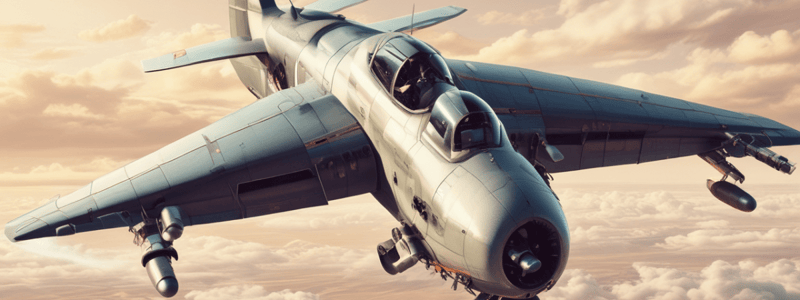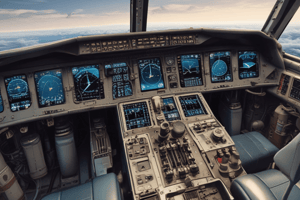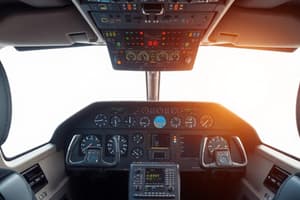Podcast
Questions and Answers
What is the primary benefit of delaying stall and providing greater control at low speeds?
What is the primary benefit of delaying stall and providing greater control at low speeds?
- Reduced maintenance requirements for leading edge devices
- Increased drag during descent and landing
- Improved lift during takeoff and landing
- Enhanced safety margin during critical phases of flight (correct)
What is a potential drawback of extending leading edge devices?
What is a potential drawback of extending leading edge devices?
- Increased surface area and drag (correct)
- Enhanced aerodynamic performance during cruise
- Improved handling during high-speed maneuvers
- Reduced lift during takeoff and landing
Why are regular inspections of leading edge devices crucial?
Why are regular inspections of leading edge devices crucial?
- To improve aerodynamic performance during cruise
- To enhance safety margin during high-speed maneuvers
- To reduce maintenance costs
- To ensure correct functioning and detect damage (correct)
What is the consequence of leading edge device failures or malfunctions?
What is the consequence of leading edge device failures or malfunctions?
What is the primary role of leading edge devices in aircraft operations?
What is the primary role of leading edge devices in aircraft operations?
How do leading edge devices impact drag during descent and landing?
How do leading edge devices impact drag during descent and landing?
What is the outcome of correct functioning and maintenance of leading edge devices?
What is the outcome of correct functioning and maintenance of leading edge devices?
What is the primary reason for the importance of leading edge devices?
What is the primary reason for the importance of leading edge devices?
What is the relationship between leading edge devices and aircraft performance?
What is the relationship between leading edge devices and aircraft performance?
What is the benefit of leading edge devices during takeoff and landing?
What is the benefit of leading edge devices during takeoff and landing?
Leading edge devices can decrease the wing's surface area during descent and landing.
Leading edge devices can decrease the wing's surface area during descent and landing.
Malfunctions of leading edge devices can only occur during takeoff and landing.
Malfunctions of leading edge devices can only occur during takeoff and landing.
Leading edge devices are only used during low-speed maneuvers.
Leading edge devices are only used during low-speed maneuvers.
The design of leading edge devices is not critical to the overall aerodynamic performance of the aircraft.
The design of leading edge devices is not critical to the overall aerodynamic performance of the aircraft.
Proper operation of leading edge devices can actually decrease the safety margin during critical phases of flight.
Proper operation of leading edge devices can actually decrease the safety margin during critical phases of flight.
Regular inspections of leading edge devices are not necessary for aircraft safety.
Regular inspections of leading edge devices are not necessary for aircraft safety.
Leading edge devices can only improve lift during high-speed flight.
Leading edge devices can only improve lift during high-speed flight.
Failures or malfunctions of leading edge devices can lead to increased lift and control during takeoff and landing.
Failures or malfunctions of leading edge devices can lead to increased lift and control during takeoff and landing.
Leading edge devices are only used in specific types of aircraft.
Leading edge devices are only used in specific types of aircraft.
The primary purpose of leading edge devices is to reduce drag during cruise.
The primary purpose of leading edge devices is to reduce drag during cruise.
What is the primary effect of leading edge devices on the wing's surface area during descent and landing?
What is the primary effect of leading edge devices on the wing's surface area during descent and landing?
During which phases of flight are leading edge devices most critical for safety?
During which phases of flight are leading edge devices most critical for safety?
What is the result of correct functioning and maintenance of leading edge devices on aircraft operations?
What is the result of correct functioning and maintenance of leading edge devices on aircraft operations?
How do leading edge devices contribute to the efficiency of aircraft operations?
How do leading edge devices contribute to the efficiency of aircraft operations?
What is the relationship between leading edge devices and aircraft performance?
What is the relationship between leading edge devices and aircraft performance?
What is the purpose of regular inspections of leading edge devices?
What is the purpose of regular inspections of leading edge devices?
How do leading edge devices affect drag during descent and landing?
How do leading edge devices affect drag during descent and landing?
What can be the consequence of neglecting leading edge device maintenance?
What can be the consequence of neglecting leading edge device maintenance?
What is the overall role of leading edge devices in enhancing aircraft safety?
What is the overall role of leading edge devices in enhancing aircraft safety?
Why are leading edge devices essential for low-speed maneuvers?
Why are leading edge devices essential for low-speed maneuvers?
Flashcards are hidden until you start studying
Study Notes
Secondary Flight Controls
- Secondary flight controls complement primary controls to enhance performance and safety in an aircraft.
- They include flaps, spoilers, trim devices, slats, and leading-edge devices.
- Unlike primary flight controls, secondary controls fine-tune performance based on various flight conditions.
Flaps
- Flaps are hinged surfaces on the trailing edge of the wings.
- When extended, they increase the camber or curvature of the wing, increasing lift for a given airspeed.
- Flaps are critical during takeoff and landing when the plane operates at lower speeds.
- They allow for a steeper approach without an increase in speed and reduce lift upon touchdown for a safe landing.
Spoilers
- Spoilers are panels on the upper surface of an aircraft's wings.
- They can be deployed to disrupt airflow and reduce lift.
- Spoilers have a dual role, allowing for quicker descent rates without increasing airspeed and aiding in roll control as an additional support to ailerons.
Trim Devices
- Trim devices are small adjustments made generally within the tail section.
- They help maintain an aircraft's stability and alleviate control pressures.
- Efficient trim usage leads to smoother flights and reduces pilot fatigue.
Slats and Leading-Edge Devices
- Slats and leading-edge devices are situated at the wing's leading edge.
- They move outward and downward to improve airflow at high angles of attack, preventing stalls.
- These devices give an aircraft the dexterity it needs to handle diverse flying conditions.
Importance of Secondary Flight Controls
- Secondary flight controls offer customizability, bringing versatility to the fingertips of a pilot.
- They modify the influences of primary controls for optimized performance.
- Each phase of flight (takeoff, cruise, approach, landing) demands tailored responses from an aircraft, and secondary controls provide this.
Role of Flaps
- Flaps are ingenious devices that enhance lift during critical phases of flight (takeoff and landing).
- By increasing the wing's surface area and altering the camber, flaps augment lift and permit aircraft to takeoff and land at lower speeds.
- Flaps are crucial for conserving runway, conserving speed, and contouring the air to a pilot's will.
Leading-Edge Devices
- Leading-edge devices are additional elements of aerodynamic wizardry that further enhance safety and performance.
- They delay the stall and provide greater control at low speeds, enhancing the safety margin during critical phases of flight.
- Leading-edge devices can also impact drag, increasing the wing's surface area and helping to slow down the aircraft during descent and landing.
- Maintenance and proper operation of leading-edge devices are essential for aircraft safety, and regular inspections ensure they function correctly and are free from damage.
Understanding Secondary Flight Controls
- Secondary flight controls are support mechanisms in an aircraft that complement primary controls to enhance performance and safety.
- They include flaps, spoilers, trim devices, slats, and leading-edge devices.
Flaps
- Flaps are hinged surfaces on the trailing edge of the wings that increase lift for a given airspeed when extended.
- They are critical during takeoff and landing when the plane operates at lower speeds.
- Flaps increase the wing's surface area and alter the camber, allowing the aircraft to takeoff and land at lower speeds.
- They are like the skilled hands of a potter, shaping the clay of the air as it molds around the wing.
Spoilers
- Spoilers are panels on the upper surface of an aircraft's wings that can be deployed to disrupt airflow and reduce lift.
- They have a dual role, allowing for quicker descent rates without increasing airspeed and aiding in roll control as an additional support to ailerons.
Trim Devices
- Trim devices are significant secondary controls that fine-tune the performance based on various flight conditions.
Flaps in Takeoff and Landing
- Flaps are essential during takeoff, reducing the required takeoff speed and shortening the runway distance needed to embark upon the skies.
- During landing, extending flaps allows the aircraft to keep its nose up, adopting a more assertive posture against the air, increasing lift, and consequently reducing speed.
- Flaps provide the stability and low-speed control necessary to ensure a safe and smooth landing in challenging conditions.
Leading Edge Devices
- Leading edge devices are critical components in the design of an aircraft's wing, serving to enhance the wing's performance in various phases of flight.
- They primarily serve to increase the camber of the wing, which in turn increases the maximum coefficient of lift.
- This allows the aircraft to generate more lift at lower speeds, which is essential during takeoff and landing.
- Leading edge devices come in several forms, including slats, slots, and Krueger flaps.
- They can also have an impact on drag, increasing the wing's surface area and drag when extended, which can be beneficial during descent and landing to help slow down the aircraft.
- Maintenance and proper operation of leading edge devices are essential for aircraft safety.
Understanding Secondary Flight Controls
- Secondary flight controls are support mechanisms in an aircraft that complement primary controls to enhance performance and safety.
- They include flaps, spoilers, trim devices, slats, and leading-edge devices.
Flaps
- Flaps are hinged surfaces on the trailing edge of the wings that increase lift for a given airspeed when extended.
- They are critical during takeoff and landing when the plane operates at lower speeds.
- Flaps increase the wing's surface area and alter the camber, allowing the aircraft to takeoff and land at lower speeds.
- They are like the skilled hands of a potter, shaping the clay of the air as it molds around the wing.
Spoilers
- Spoilers are panels on the upper surface of an aircraft's wings that can be deployed to disrupt airflow and reduce lift.
- They have a dual role, allowing for quicker descent rates without increasing airspeed and aiding in roll control as an additional support to ailerons.
Trim Devices
- Trim devices are significant secondary controls that fine-tune the performance based on various flight conditions.
Flaps in Takeoff and Landing
- Flaps are essential during takeoff, reducing the required takeoff speed and shortening the runway distance needed to embark upon the skies.
- During landing, extending flaps allows the aircraft to keep its nose up, adopting a more assertive posture against the air, increasing lift, and consequently reducing speed.
- Flaps provide the stability and low-speed control necessary to ensure a safe and smooth landing in challenging conditions.
Leading Edge Devices
- Leading edge devices are critical components in the design of an aircraft's wing, serving to enhance the wing's performance in various phases of flight.
- They primarily serve to increase the camber of the wing, which in turn increases the maximum coefficient of lift.
- This allows the aircraft to generate more lift at lower speeds, which is essential during takeoff and landing.
- Leading edge devices come in several forms, including slats, slots, and Krueger flaps.
- They can also have an impact on drag, increasing the wing's surface area and drag when extended, which can be beneficial during descent and landing to help slow down the aircraft.
- Maintenance and proper operation of leading edge devices are essential for aircraft safety.
Studying That Suits You
Use AI to generate personalized quizzes and flashcards to suit your learning preferences.




